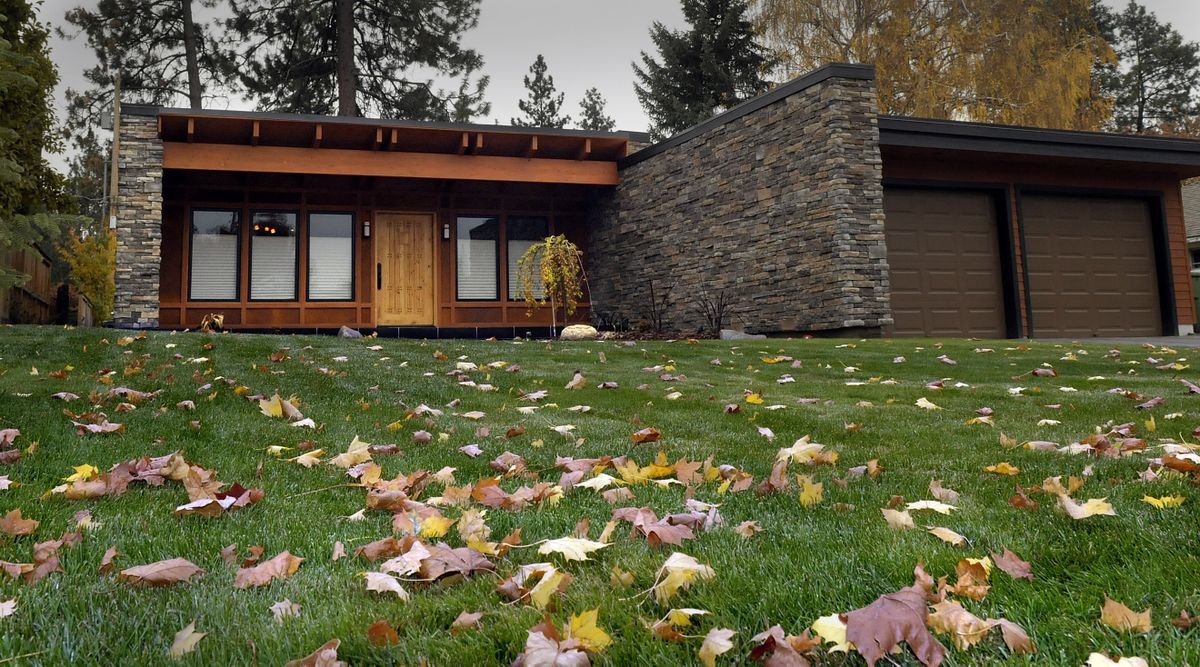Out of the rough
Todd Wood transforms 1950s Manito ‘bomb shelter’ with a stunning makeover
Now: With the help of architect Denny Christenson and interior designer Kris Bacon, Wood’s home is finished. (Christopher Anderson / The Spokesman-Review)
Location. Location. Location.
The age-old real estate rule applied when Spokane resident Todd Wood first eyed his 1954 ranch-style house overlooking the fourth hole of Manito Country Club’s golf course.
The avid golfer joined the club about four years ago and had been searching for a home on its rim. Two years later, when two houses went on the market on the course’s north side, Wood chose the one he felt had a better view – despite the fact that the house looked “ugly and worn down,” he said.
“Early on it had a few pet names coined by friends and co-workers,” Wood said. They’d say to him, “ ‘Hey, Woody. How’s the bomb shelter coming along?’ Or, ‘Hey, Woody. I drove by the crack house yesterday. Looking good.’ ”
But Wood saw potential: Great southern exposure. Ten-foot-high ceilings. And, of course, access to the course.
“I thought it had the potential to be a very open, mid-century modern home like you might see in Palm Springs,” he said. “You know, with that indoor-outdoor living space.”
After taking possession in February 2007, Wood, interior designer Kris Bacon, of i.d. Studio, and Spokane architect Denny Christenson redesigned the house, giving it an open floor plan that connects the main living area to the course via five sets of floor-to-ceiling French doors. Wood knocked out a massive fireplace and installed windows where there once were walls.
Rock veneer covers one wall of the great room, broken up only by a gas fireplace and a slim television that hangs above it. A large, L-shaped sectional couch faces the rock wall.
Behind the couch is the kitchen, with granite countertops, stainless steel appliances and a wall of copper-colored glass accent tile. In the center of the kitchen is a butcher block-topped island that offers plenty of room for food prep.
Wood, who is single, placed a pool table in a space others might have assumed a dining table would go.
The contemporary facelift drastically changed the feel of the home, but the house’s horizontal profile stayed the same, preserving its mid-century roots and enabling it to continue to blend with the 1950s-era neighborhood.
“I wanted a pitched roof (at first), but Denny said, ‘No. Keep the character of the home intact,’ ” said Wood, 46, a creative director for Next IT Corp.
Christenson, the architect, said he liked the home’s original lines.
“It’s a small home and well-designed to start with, for the time it was designed,” he said. “It just had aged a little, so it didn’t fit Todd’s lifestyle.”
Christenson said he, Bacon (who is his daughter) and Wood didn’t have a particular style – such as modern, Northwest or prairie – in mind as they planned the transformation.
“We designed the remodel to continue on with the same style it was, but to provide some punch to it with wood and stone,” he said.
Before Wood even purchased the house, he’d found the home’s original blueprints – penned by Spokane architect Frank Y. Toribara – in the basement.
“I wanted to make sure I could open it up,” he said of the floor plan.
Wood determined that he could knock out walls without compromising the home’s structural integrity.
The large brick fireplace, which included an indoor grill on one side, was one of the first things to go. Wood said it “consumed the room.”
“Everyone told me I was crazy” for taking it out, he said, “but I knew I was going to update (the house) all the way, so why hold back?”
Wood agreed to pay a contractor a set amount to remove the fireplace, but after seeing how hard the man was working to demolish it, he insisted on giving him more.
With the fireplace out of the way, Wood was able to extend the kitchen several feet toward the front of the house. He also extended the home’s back wall to the south by about eight feet, gaining an extra 200 square feet of interior space.
That south-facing wall now is comprised of the five sets of French doors, three of which are operational. On warm days, Wood opens all three, blurring the line between the home’s interior and exterior. During summer, the golf course’s tall pine trees buffer the house from the sun’s powerful rays.
Wood lived in a construction zone for about a year while the remodel was under way. He did some of the work himself and with the help of his father, who would travel to Spokane on the weekends from the Tri-Cities.
Wood set up a makeshift kitchen in what’s now an office, cooking his meals in a microwave and washing dishes in a bathtub.
“The nights I remember most are when I had the back of the house open, when we were waiting for the doors,” Wood said. “I remember the wind blowing around the plywood” that covered the openings.
The pounding of plywood and annoyance of dust was worth the end result, Wood said.
And Christenson liked working on a project that wasn’t a complete teardown of the existing home. With many of his clients who remodel old houses, “there’s a tendency to make them big, but it was nice to have a small home to work on,” he said.
“Most people, when they’re going to sink money into a remodel, really change it a lot, try to revamp it and make it something it wasn’t before,” Christenson said. “With this one, we were able to enhance what was existing. I get as much satisfaction, or maybe more, out of that.”



